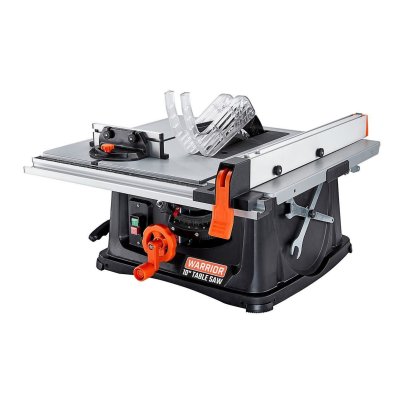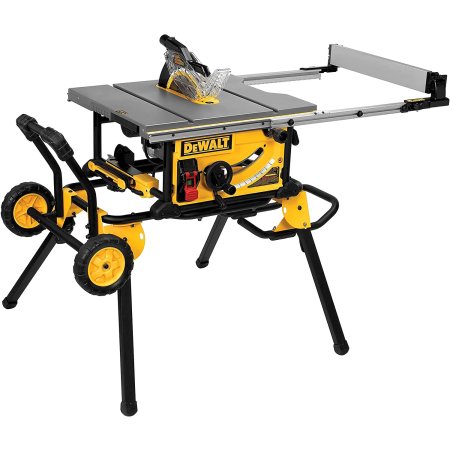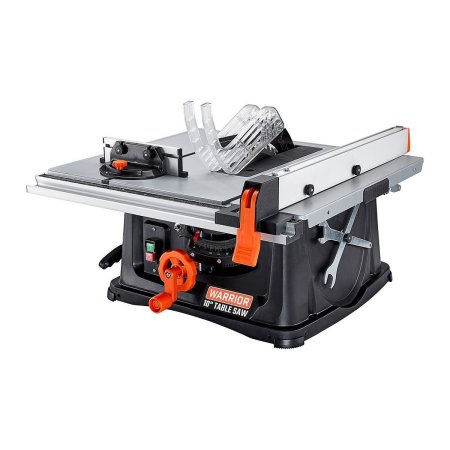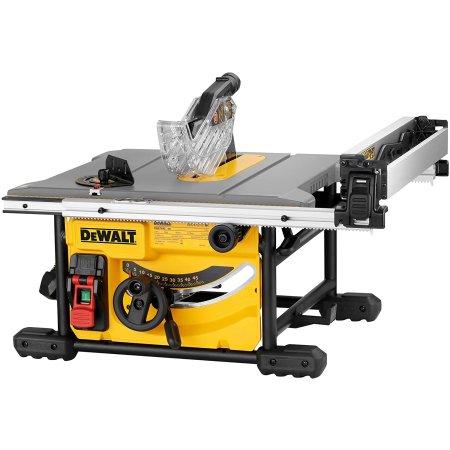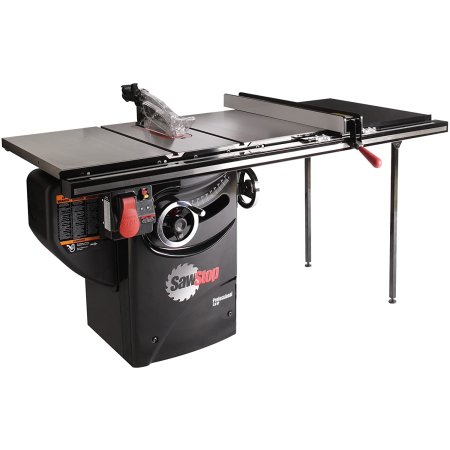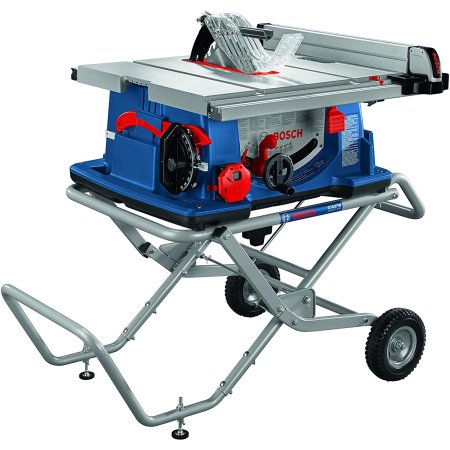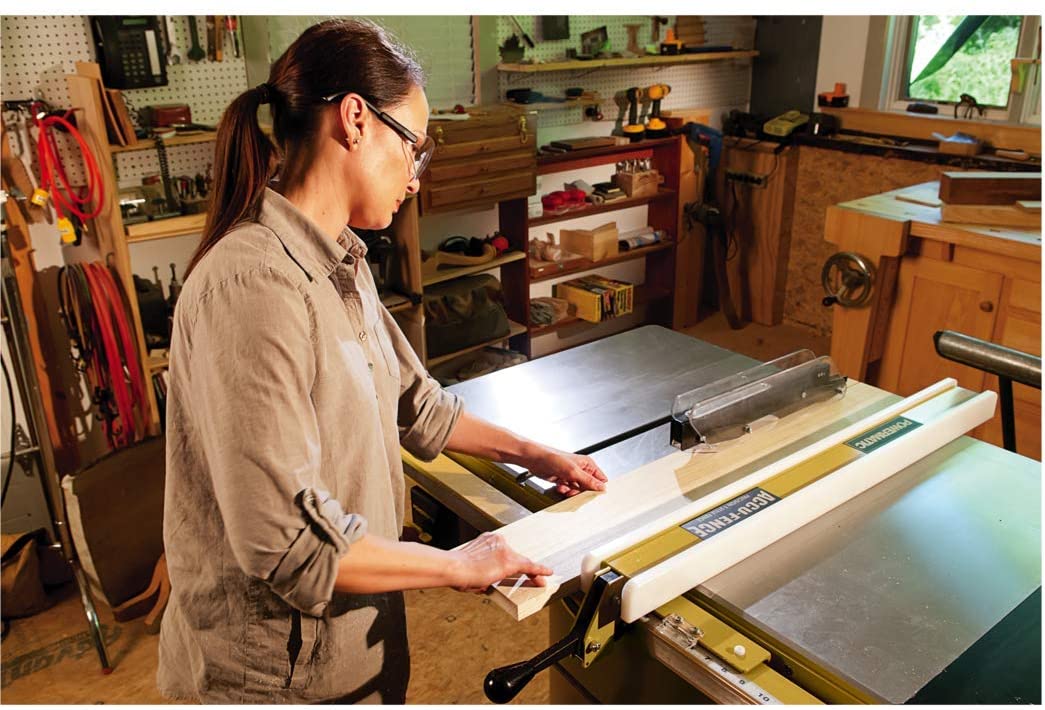
We may earn revenue from the products available on this page and participate in affiliate programs. Learn More ›
When shopping for table saws for beginners, the primary focus must be safety. In many cases, this means not settling for the cheapest model, which may not be as stable as a higher-priced brand. A table saw is often the most expensive power tool in the workshop, but don’t cut corners when buying this tool. Because of the exposed nature of the blade, table saws present a risk of injury—especially to fingers.
Fortunately, table saws are designed with safety features that reduce the risk of injury. Beginners need a sturdy, well-made table saw that allows them to make precision cuts in the safest manner possible. Learn what to look for when shopping for the best table saw for beginners and find out why the following models are suitable for table-saw newbies.
- BEST OVERALL: DEWALT 15 Amp Corded 10 in. Job Site Table Saw
- BEST BANG FOR THE BUCK: WARRIOR 10 In. 15 Amp Table Saw
- BEST FOR WORKSHOP: RIDGID 13 Amp 10 in. Professional Cast Iron Table Saw
- BEST LIGHT-DUTY: DEWALT Table Saw for Jobsite, Compact, 8¼-Inch
- BEST STATIONARY: SAWSTOP 10-Inch Professional Cabinet Saw, 3-HP
- BEST PORTABLE: Bosch 10 in. Worksite Table Saw with Gravity-Rise
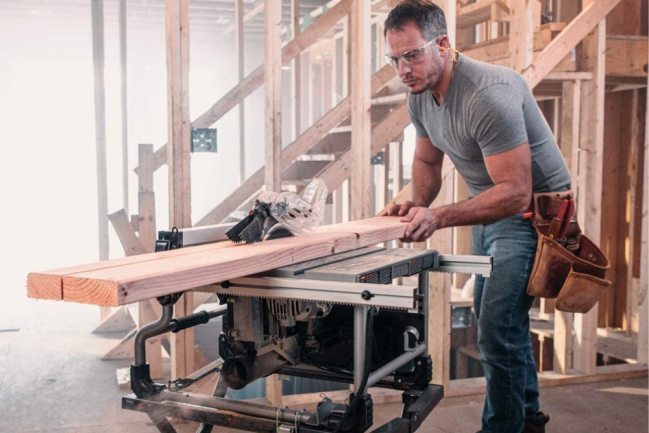
What to Consider When Choosing the Best Table Saws for Beginners
Like many power tools, the best saws for beginners come in various types, with some better suited for specific kinds of cutting than others. Purchasing a table saw is an investment in woodworking. Top considerations include the variety of projects and whether the user plans to make basic or advanced cuts.
Type
Table saws are either “portable” or “stationary.” Within those two categories are a few subtypes.
- Job site: These are also called “contractor table saws,” and they are among the more powerful portable table saws. They come mounted on stands, which may collapse for easy transport. Job-site table saws are durable, have full-size blades (10 inches), and are made for repetitive use.
- Cabinet: Cabinet table saws are the kind in virtually every high school woodworking shop, because they’re extremely heavy, and it’s difficult to accidentally move one around. Designed to withstand years of use, they’re often made from cast iron. They’re also highly desirable for woodworkers who have plenty of room in their workshop.
- Size: In table saws, size refers to the diameter of the blade the tool can accommodate rather than the size of the saw itself. Most table saws take 10-inch blades, and some contractor-type models use 12-inch blades, while a few take smaller 8¼-inch blades. Larger blades means the ability to cut thicker wood, but a 10-inch blade is suitable for most cutting purposes.
Motor Power
A table saw is only as powerful as its motor. Today’s models come with two different types of motors, each offering a range of power.
- Belt-drive motors: These are the big boys in table saws and the type on stationary and cabinet table saws. They produce anywhere from 3 to 5 horsepower (HP), but they must be connected to a 20-amp breaker or a 220-volt outlet.
- Direct-drive motors: Most DIY and even most contractor table saws come with direct-drive motors. They top out around 2.4 HP, and they plug into a standard 120-volt household outlet. They’re not as powerful as belt-driven motors, but they’re often louder.
Table Size
The flat iron table on a table saw helps determine the maximum dimensions of the material that the saw can safely cut. A larger table means the saw can more easily and more cleanly cut large sheets of wood such as plywood.
- Rip capacity: A rip cut is a cut along the length of the material, so rip capacity indicates the widest material the saw can cut. Rip capacity is determined by how far the rip fence can be moved away from the blade. Typical rip capacities include 28 inches, which is standard for compact table saws, and 30 inches, which is preferred by most contractor and prosumer DIY woodworkers. Cabinet table saws come with rip capacities of up to 50 inches, making them suitable for cutting wide sheet materials, such as full sheets of plywood.
- Crosscut capacity: A table saw’s crosscut capacity varies. It’s determined not by any measurement on the saw, but rather by how large a piece of material the user can securely hold while feeding it into the blade. It’s not uncommon to make a crosscut on a sheet of plywood wider than the table space in front of the blade.
Fence
Another vital consideration when choosing the best starter table saw is “stable fence,” or “rip fence.” This adjustable bar that runs parallel to the blade extends from the front to the back of the table. The fence helps keep the cuts straight and precise.
If shopping in person, adjust the fence back and forth to determine its ease of movement as well as its stability when locked in place. A flimsy fence can shift while cutting, resulting in crooked cuts. When shopping online, take the time to read customer reviews to find out if previous buyers reported good results when adjusting the fence.
Safety
Safety is a top priority when choosing a table saw, and stability is among the most critical safety components. Cheap, lightweight table saws that can tip during use are an accident waiting to happen, especially for a new user learning how to use a table saw. Other safety aspects to consider include:
- Kickback: This occurs when the user feeds the material into the saw and the spinning blade catches the material and throws it in any direction. It can also pull the user’s hand toward the blade. Some table saws come with kickback claws that help secure the material flat to the table during cutting.
- Push blocks: These blocks (or sticks) are used to secure the material being cut and push it through the blade rather than using bare hands. Some users report difficulty using these pushing accessories; however, even pros use them, and it’s better than losing a finger.
- Blade guard: Virtually all table saws sold today come with blade guards that slide over the spinning blade to reduce the risk of injuries.
Additional Features and Accessories
Although they vary in power, quality, and size, table saws are relatively straightforward power tools. In addition to the basics, a few additional features and accessories are available.
- Mitering capability: Most table saws, even cheaper models, allow the ability to set the blade at an angle, usually from 0 to 45 degrees, to make miter (bevel) cuts.
- Magnetic switch: Most table saws come with a standard on/off switch, typically on the front of the tool. A few have magnetic switches that automatically shut off the saw if the motor overheats.
- Dust collection: Not all table saws offer this feature, but if they do, it can be helpful when the saw is operating in an indoor setting. Most dust collection ports are designed to attach to standard wet/dry vacuum hoses to help collect the finer bits of sawdust that would otherwise fill the air.
Ease of Use
Ease of use on a table saw is related to its stability, the locking mechanism on the rip fence, its precision miter adjustment, convenience of the power switch (front of the machine), and a large iron table to hold material. Again, all these factors play into selecting a high-quality tool.
Although it may seem counterintuitive, bigger is often better when it comes to the best table saws for beginners. A larger table saw is often heavier and more stable, which means it’s safer and easier to use. Trying to keep a table saw from tipping when ripping large sheets of plywood isn’t something even a pro wants to do.
Brand and Warranty
Some of the most reputable brands of table saws also come with the best warranties. For example, DeWalt, SKIL, and Rockwell have 3-year limited warranties. Powermatic table saws usually come with an even longer 5-year warranty.
Read the fine print, though, because some power tool manufacturers cover only those repairs made by their own technicians. So if a brand-specific technician isn’t in your community, the company may charge shipping fees for repairs.
Most warranties are limited to damage or failure caused by factory defects. Using the table saw in a manner for which it wasn’t intended, such as cutting iron, usually voids the warranty. This is just one more reason to read the owner’s manual carefully before using the tool.
Our Top Picks
To be included in this lineup of the best table saws for beginners, we determined that the following models are both stable and straightforward to operate. Safety is the number one concern when learning how to use a table saw, but the ability to make precise cuts is also critical. In selecting the models for this lineup, we insisted that the following models offer both. While these table saws vary in best usage, each is a standout in its category, and all are among the best saws for woodworking.
Best Overall
DEWALT 15 Amp Corded 10 in. Job Site Table Saw
Pros
- Suitable for cutting 4×8 sheet goods
- Safety blade guard
- Sturdy and stable
- Easy-to-adjust fence and miter
Cons
- Molded plastic wheels
Product Specs
- Rip capacity: 32½ inch
- Blade diameter: 10 inch
- Amps: 15 amps
Coming in as the best overall pick for a table saw for beginners is a model from one of the top manufacturers of power tools. The DeWalt 15 Amp Corded 10 in. Job Site Table Saw offers a combination of power, precision, and safety features that make it attractive to new users as well as seasoned carpenters. The saw comes with an easy-to-adjust fence and an ample 32½-inch rip capacity that allows users to cut large sheet materials.
The DeWalt table saw weighs in at a hefty 110 pounds, but it has built-in wheels that allow the user to tip the table on its side to roll it from one spot to another. The saw blade tilts up to 45 degrees to make miter and bevel cuts, and the tool comes with a blade guard and an optional dust port. As an added perk, the DeWalt Table Saw has an onboard storage compartment for storing small devices, such as wrenches or miter gauges. This table saw offers an excellent combination of safety, usability, and precision cutting.
Get the DeWalt 10-inch table saw at The Home Depot, Lowe’s, or on Amazon.
Best Bang For the Buck
WARRIOR 10 In. 15 Amp Table Saw
Pros
- 15-amp motor
- Affordable
- Onboard storage
- Stable on benchtop
Cons
- Limited 9-inch rip capacity
Product Specs
- Rip capacity: 9 inches (right or left)
- Blade diameter: 10 inches
- Amps: 15 amps
The Warrior 10 In. 15 Amp Table Saw won’t win any awards for cutting the largest sheet materials, but it ticks all the boxes for a powerful saw that offers both safety and precision. Best of all, it comes at a very affordable price point.
The Warrior table saw is a standard benchtop table saw, and it weighs 36 pounds, which is heavy enough to keep it from sliding most of the time—but it also has rubber feet that keep it securely in place. Its rip capacity is 9 inches, which is on the narrow side but adequate for cutting many of the boards used in standard woodworking. The fence slides smoothly and locks securely into place for making precise cuts, and it can be attached to either side of the table. The Warrior also makes miter cuts up to 45 degrees and comes with a dust-collection port.
Get the Warrior table saw at Harbor Freight.
Best For Workshop
RIDGID 13 Amp 10 in. Professional Cast Iron Table Saw
Pros
- Very stable
- Smooth rip-fence operation
- Safety blade guard
Cons
- 13-amp motor
Product Specs
- Rip capacity: 30 inches
- Blade diameter: 10 inches
- Amps: 13 amps
For those who have the space for a dedicated table saw, the RIDGID 13 Amp 10 in. Professional Cast Iron Table Saw is a serious contender. This heavy-duty saw weighs a beefy 267 pounds, so it’s better suited to one spot, although it could be used as a primary job-site saw if it can stay put throughout the project. It features a 13-amp motor and comes with a 30-inch rip capacity for cutting large sheet materials.
The RIDGID table saw can cut miters up to 45 degrees, and it comes with a dust-collection port for reducing airborne dust in the workshop. The fence slides smoothly and locks snugly into place for making precision cuts. The saw features a safety blade guard and a metal stand with rubber feet for anti-slide stability. It also comes with a push stick and an onboard storage compartment for small tools.
Get the RIDGID table saw at The Home Depot.
Best Light-Duty
DEWALT Table Saw for Jobsite, Compact 8¼-Inch
Pros
- Compact
- Powerful
- High-quality construction
Cons
- Relatively small 24½-inch rip capacity
Product Specs
- Rip capacity: 24½ inches
- Blade diameter: 8¼ inches
- Amps: 15 amps
Using a compact table saw doesn’t mean giving up power and precision. Weighing 56 pounds, the DeWalt Table Saw is smaller than some of its competitors, but it still packs a punch. This table saw accommodates a smaller 8¼-inch blade, but it features a 15-amp motor and comes with a modular guard system for safety. It also offers a smooth-slide fence with precision locking.
This DeWalt table saw has kickback pawls (or claws) that help secure the material to reduce the risk of kickback. It comes with a push stick for safe cutting. Its rip capacity is 24½ inches, making it suitable for cutting moderate-size sheet materials, and it cuts miters up to 48 degrees. It comes with onboard tool storage and can be used as a portable table saw or mounted to a workbench for added stability.
Get the DeWalt 8¼-inch table saw on Amazon, at Lowe’s, or at The Home Depot.
Best Stationary
SAWSTOP 10-Inch Professional Cabinet Saw, 3-HP
Pros
- Very stable
- Suitable for cutting large sheet materials
- Advanced safety system
Cons
- Not portable
Product Specs
- Rip capacity: 36 inches
- Blade diameter: 10 inches
- Amps: 13 amps (3 HP motor)
The SawStop 10-Inch Professional Cabinet Saw offers many high-end features, but it’s not portable. This behemoth of a saw weighs 426 pounds, so figure out the best spot in the workshop for it—and then leave it there. The SawStop offers an impressive rip capacity of 36 inches, so it can cut the largest sheet materials. The saw comes with a precision adjustable fence, a dust-collection port, and a blade guard for safe cutting.
The most significant difference between the SawStop and the other saws in this lineup is its power. The SawStop comes with a 13-amp (3 HP) motor. The added horsepower requires the user to plug the saw into either a 220-volt outlet or a 20-amp outlet. The SawStop also features cutting-edge safety technology that detects when the blade makes contact with skin (because skin is conductive), and it immediately shuts down the motor to reduce serious injuries. In addition, when the blade stops spinning, it drops beneath the table level to prevent scrapes and cuts from brushing against the exposed blade tips.
Get the SawStop table saw on Amazon or at Acme Tools.
Best Portable
Bosch 10 in. Worksite Table Saw with Gravity-Rise
Pros
- Portable
- Powerful
- Smart Guard System
- Extendable table increases rip capacity
Cons
- Must be used on level ground
Product Specs
- Rip capacity: 30 inches
- Blade diameter: 10 inches
- Amps: 15 amps
Walking to and from a stationary table saw in the garage to a DIY project in the backyard can get tiresome, but that won’t be an issue with the Bosch 10 in. Worksite Table Saw. This powerful 15-amp saw offers plenty of cutting power, and it’s a snap to move. The saw mounts to a wheeled stand that collapses and turns on its side—like a dolly—making it easy to pull.
Setting up the Bosch saw is also simple when the user reaches the work area, thanks to a gravity-rise system that helps elevate the tool to working height. The saw also comes with a 30-inch rip capacity, a self-aligning rip fence for making precise cuts, and an easy-to-adjust miter gauge that cuts up to 45 degrees. The saw’s Smart Guard System shields the blade and reduces kickback.
Get the Bosch table saw at The Home Depot or Lowe’s.
Our Verdict
Any of the options in this lineup of the best table saws for beginners is suitable for newbies looking to purchase their first table saw, but the best overall pick, the DeWalt 10 inch table saw, ticks all the boxes. It offers a good blend of power, safety features, and precision cutting. The best budget model, the WARRIOR table saw is stable, and it comes with some features also found on more expensive models.
How We Chose the Best Table Saws for Beginners
In selecting the best entry-level table saw options for this lineup, we determined essential needs for those just learning to use this power tool. While beginner tools in other categories are often less powerful—or a lot less expensive—that rule of thumb does not hold true when it comes to table saws. Injuries from table saws, typically finger or hand amputations, are more common than injuries from other power tools, so this is not the tool to skimp on quality and safety features.
With that in mind, we exhaustively researched dozens of today’s top table saw models to choose units that are easy to use, safe, sturdy, and accurate. We looked at models from well-known manufacturers that have earned a reputation for quality. Still, we didn’t automatically exclude models from smaller or niche manufacturers if they feature quality materials and have a stellar reputation.
Table saws aren’t cheap tools, but a good one should last for years and provide a high level of safety.
FAQs
Adding a table saw to a power tool collection opens up a whole new realm of woodcutting possibilities, mainly offering the ability to make straight lengthwise cuts (rips) on the material. Those shopping for the best saw for beginners likely will have some questions.
Q. How many horsepower does a 15-amp table saw have?
Horsepower is relative to the saw’s motor and the amount of electricity the saw draws. A 15-amp table saw that plugs into a standard 120-volt outlet can only produce a maximum of 2.4 HP, which is based on the 120-volt outlet producing 1,800 watts of electricity.
Q. Can I rip a 2×4 board on a table saw?
Yes, but use a push block to guide the wood through the blade to ensure your fingers don’t get too close to the blade.
Q. What should you never use a table saw for?
Never use a table saw to make curved cuts; table saws are designed for straight cuts only. Trying to feed the material into the blade at an angle increases the risk of the blade catching the material and sending it flying. In addition, don’t feed material into the saw from the back end, which also increases the risk of kickback. Don’t use a table saw to cut plastic, PVC, or ferrous metals—it’s not designed for that.
Q. Can you cut against the grain on a table saw?
Yes, you can make crosscuts with a table saw. For best results, use a crosscut blade.
Q. What are five safety rules for a table saw?
- Read the operator’s manual and familiarize yourself with the saw before making any cuts.
- Wear safety glasses and hearing protection.
- Use a push block to feed material through the blade rather than your fingers.
- Start the blade before feeding material into it—never position the material against the blade and then turn on the power.
- Always unplug the table saw before changing blades.
Q. What are the most important features on any table saw?
The most critical features on a table saw are the blade, safety guard, rip fence, and miter gauge.
Q. How do I properly use a table saw?
Always study the operator’s manual and follow all safety precautions. Cut only wood or wood-fiber products and keep children, pets, and others out of the immediate area while working. Table saw injuries are high on the list of power tool injuries, but most can be avoided by following good safety techniques.

